Be yourself; Everyone else is already taken.
— Oscar Wilde.
This is the first post on my new blog. I’m just getting this new blog going, so stay tuned for more. Subscribe below to get notified when I post new updates.
Historic Gear for the Modern Adventurer
Be yourself; Everyone else is already taken.
— Oscar Wilde.
This is the first post on my new blog. I’m just getting this new blog going, so stay tuned for more. Subscribe below to get notified when I post new updates.
AKA, the Poncho Liner
If you have served in the US Military since the 1960s, you know a secret that your non-military brethren may not know. That secret is a humble piece of equipment that does not seem like such a big deal, at least not until you are sitting on or curled up on the cold ground in the middle of the night. Then that secret is the best thing that has happened in your life in recent memory; the nylon quilted poncho liner, affectionately known to us ground troops as the “Woobie.”
“Woobie” is a word that you generally don’t expect to hear from weapon laden warriors, and I confess that the first time I heard it I thought my Sergeant was making fun of me. He was sending me out to a Listening Post (LP), or a small fighting position outside the main perimeter designed to detect enemy movement. “You’ll be out on the LP all night by yourself, so bring your woobie and extra radio batteries.” My puzzled look must have struck him as funny. “My woobie, Sa’rnt?” I asked. “Yes, your woobie, Private. Your poncho liner. Without it, you woobie cold.” I sure as hell would be; it was November in West Germany. I added yet another term to my growing vocabulary of military jargon that has never left me. I have since used the same phrase with my troops many times, “Without it, you woobie cold.”
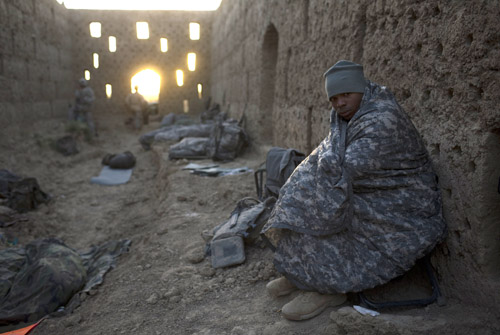
My woobie has been an integral part of my equipment ever since. The woobie came into being in 1963, just prior to the Vietnam War. Over the years they have changed camouflage patterns to match the whims of Pentagon procurement pogues, from early ERDL type camo first used in Vietnam to the most current Muti-Cam and MARPAT patterns, and everything in between.
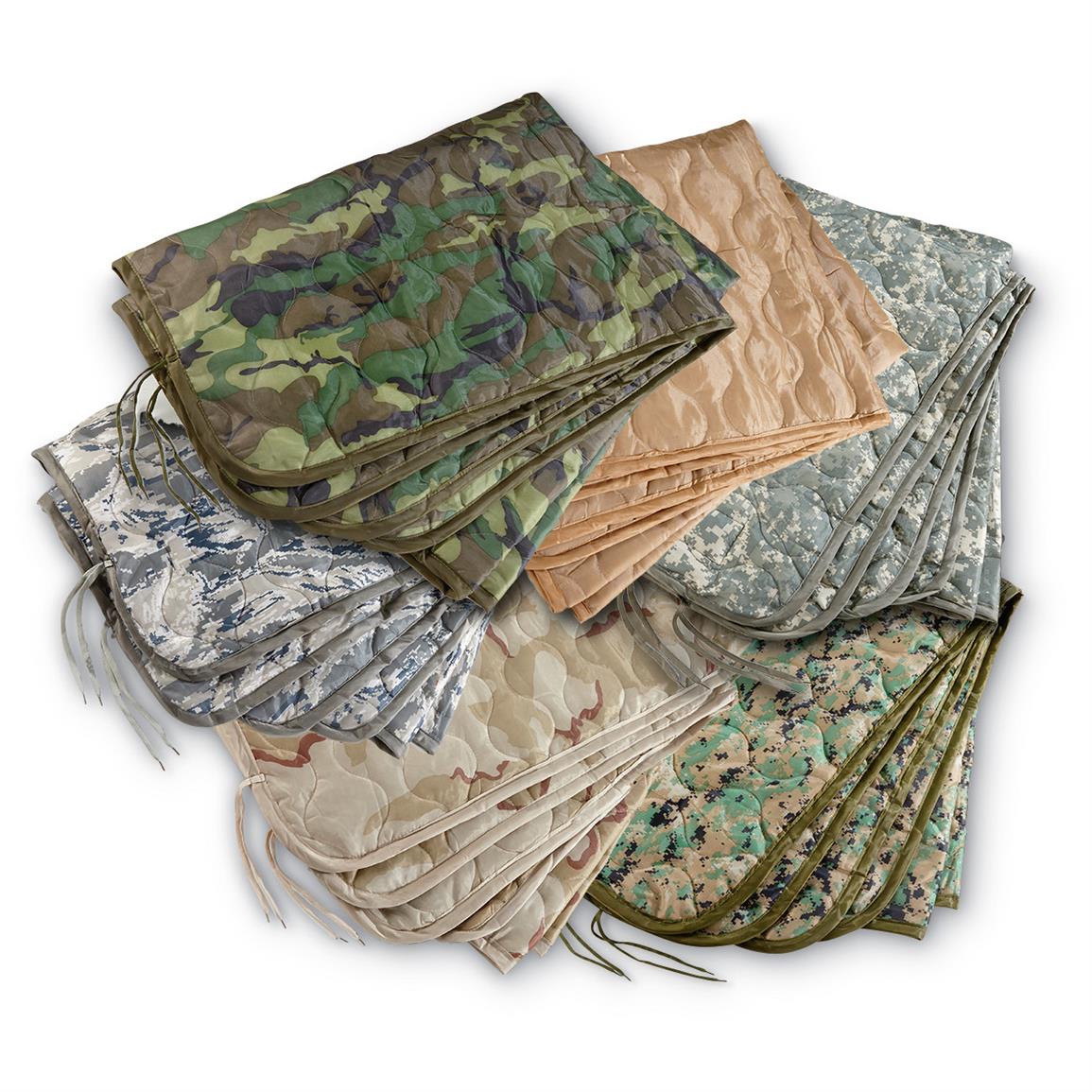
The simple woobie, as its official name suggests, is designed as a poncho liner. Military ponchos get used for a lot more than keeping rain off soldiers. They are tarps, ground covers, makeshift stretchers, and sometimes even body bags. The poncho liner has cloth ties on each corner and in the middle of each side so that it can be attached to the metal grommets on the poncho. With the head hole tied closed and the snaps fastened it doubles as a sleeping bag, although it is more commonly used separately from the poncho, because getting caught in a snapped-up poncho during an attack can turn your poncho into your last resting place. Constructed of 1.9oz Ripstop nylon cloth with thick Polyester batting sandwiched between the outer layers, and it is quilted for added strength and durability. It has a band of extra quilting along the width of the center for even more durability. It measures about 82″ x 62″, and features a rolled nylon edge binding which prevents tattering or edge wear.

Poncho liners have even been modified by soldiers and seamstresses the world over. That process actually began before the advent of poncho liners, with the woobie’s predecessor; the wool blanket. Wool blankets have been cut up and used as cold weather liners for field clothing since the advent of wool blankets. In the 1960s military ponchos were OD Green rubber coated canvas contraptions that worked pretty well but were very heavy by modern standards. Some enterprising GIs had their ponchos tailored into raincoats with zippers, some even added wool blankets for lining. In the 1970s the Army adopted the zippered rain jacket, but without a liner. So, my era, the 1980s, led to the advent of the poncho liner sewn into the rain jacket as a liner. We called them “Graf Parkas,” after the name of our biggest, muddiest training area in Germany, known as Grafenwohr. Graf parkas were the symbol of the seasoned soldiers, those who were not on their first rodeo, and were therefore highly sought after by those of us that were on our first rodeo. The US Military has since developed a great liner that can be added or removed by means of buttons and they are standard in all field jackets and Goretex rain gear.
The woobie, however, remain essentially unchanged. It is still one of the most commonly carried and used pieces of field gear in the US military. Even in those units that must move rapidly and therefore carry as little as possible, the woobie abounds. We have an old adage in the Army; “Travel Light, Freeze at Night.” It is not uncommon to reach your tactical objective before dawn and throw yourself on the ground for a nap with just your woobie to cover you. The “Freeze at Night” part is less likely if you bring your woobie.
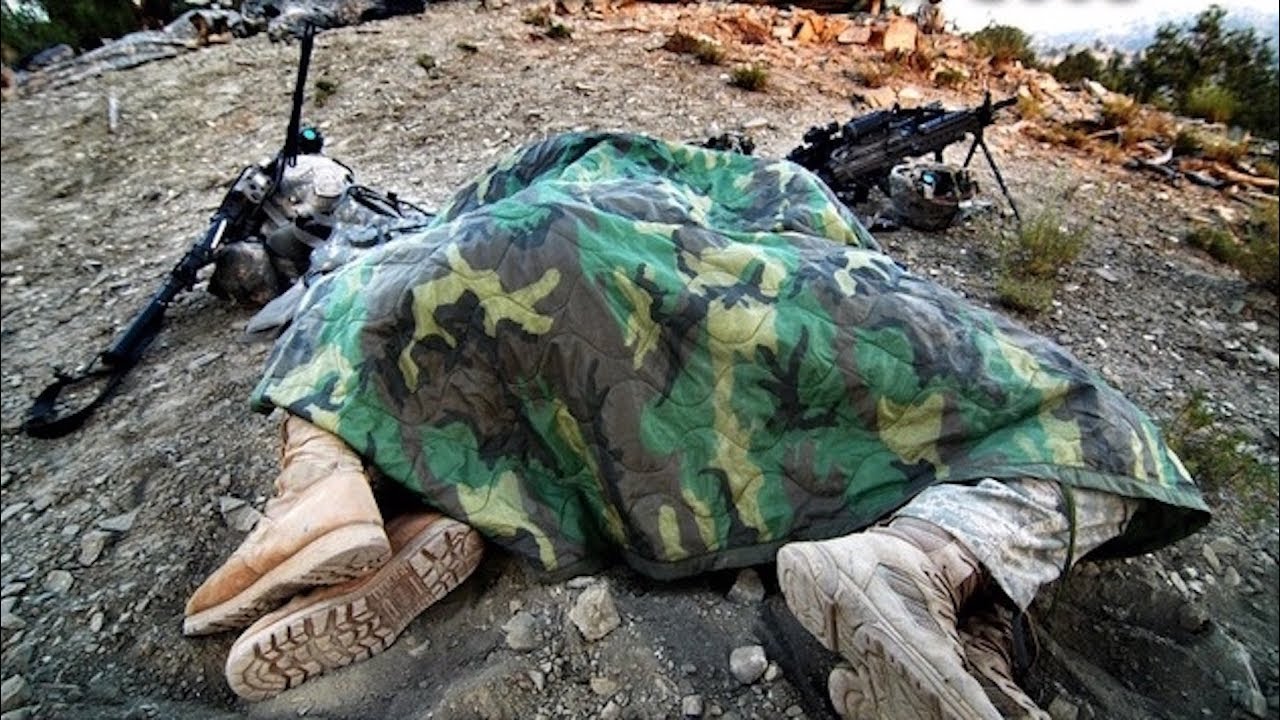
Like many other veterans, my woobie holds a special place in my heart. Of all the things that have sucked and failed in my life, my woobie is not one of them. I still have and still use the first poncho liner I was issued in the Army. I told my supply SGT that I lost it, because I preferred to pay for it rather than give it back. That peace of gear outlasted my first marriage and is older than all my children. All of my children have temporarily adopted one of my woobies at some point in their childhood. Temporarily.
Poncho liners are available from numerous sources and are pretty affordable at around $30.00. Now that I have shared the military secret with all of my readers, military and otherwise, all I can do is hope you take my advice: Travel light, (but don’t) freeze at night.
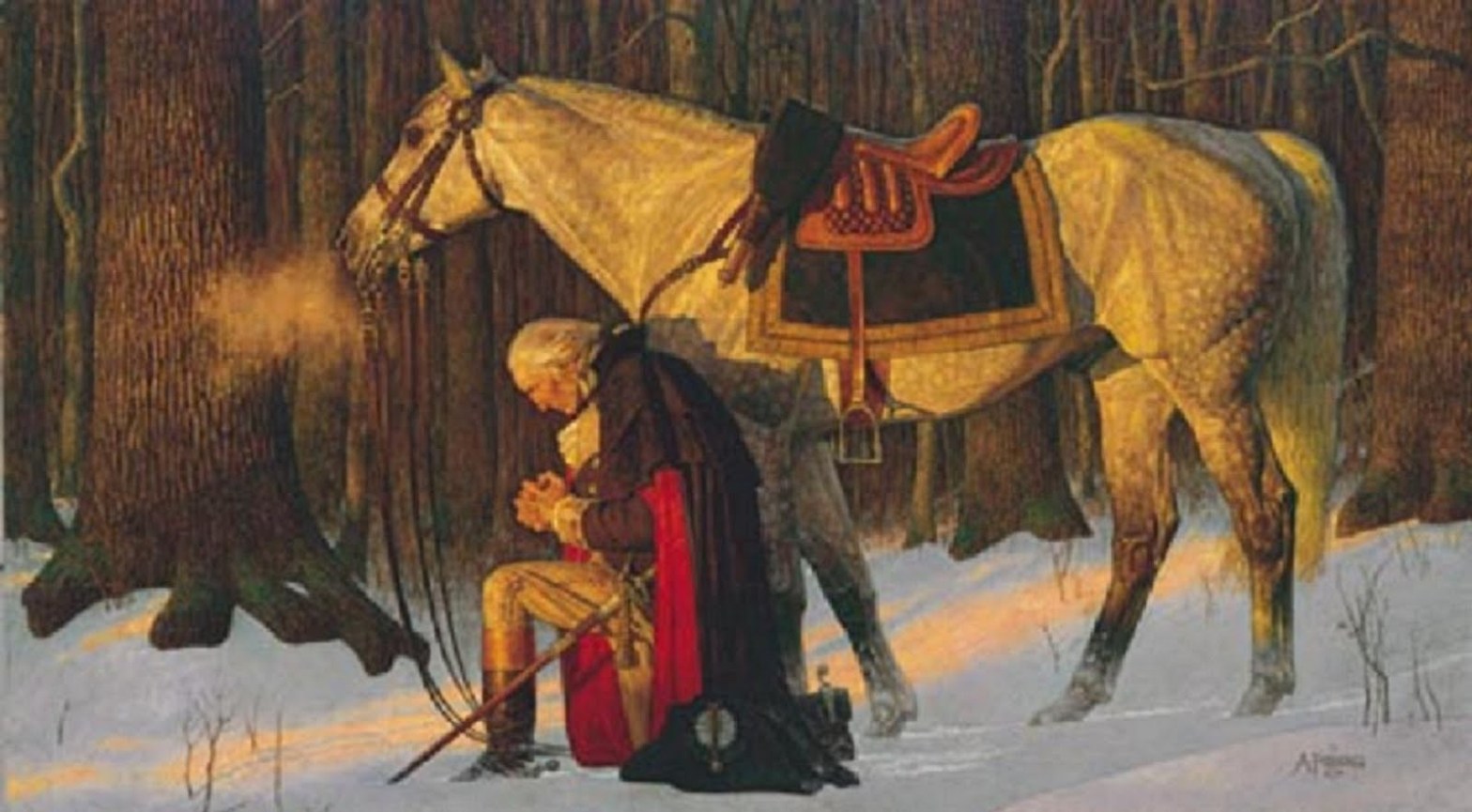

Whether you are a professional soldier, law enforcement officer, first responder, or an avid outdoor enthusiast you need to know that the gear you use is going to do the job you intend it for. I have been an outdoors man, hunter, and fisherman since I was a kid. I bring nearly forty years of experience as a soldier, police officer, combat lifesaver, armorer, gunsmith, and author to this blog where I review gear from all over the world and many points in history. I hope this blog helps you think through your choices in gear and make decisions that will result in your life-long success in the world, where ever you go and whatever you do.
You might think this sounds like a lot of areas to discuss in one little blog, and maybe it is, but in the end it all boils down to the stuff you choose to buy and use in your life. There are a lot of choices to be made and a lot of stuff being made as inexpensively as possible and sold for as much as possible, and some of it is awesome, like Mora Knives, and some of it is pure junk. You won’t know unless you spend the money and try it out for yourself, or unless you let someone else do it for it for. I have already done a lot of it for you, so learn from my mistakes and my experience. It costs you nothing, zero, nada, zilch. And it gives me an excuse to tell you about what I learned.
Much of the gear I discuss on this blog is historical. You may believe that it will not help you to know about historic gear, like East German canteens, but it might. Much of the gear used by armies of the past is still useful today, and some of it is readily available and pretty inexpensive. A mess kit used by the Imperial Japanese Army during WW2? Still useful today for many purposes. So don’t be surprised to see things that may cause you to wonder why I am discussing them, but I also invite you to ask for reviews of gear that interests you. I may have already used it.
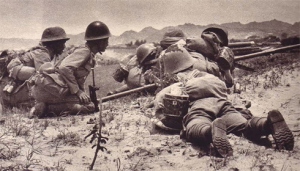 |
| The IJA troops in the right side of this photo carry their mess kits into combat. |
Prior to the Second World War the Imperial Japanese Army received training and education from Germany and Prussia. In 1885 Japan welcomed Prussian Major Klemens Wilhelm Jacob Meckel as an instructor for the IJA. Not only did Major Meckel embark on an ambitious program of training, but he reorganized the IJA in the Prussian model; making it an expeditionary army designed to conquer foreign territory. As a result, a change in the styles of field gear carried by IJA soldiers began, one that changed Japanese equipment to resemble Prussian and later German equipment. The one piece of field gear that exemplifies this change best is the mess kit used by IJA and IJN ground forces during the Second World War.
The IJA mess kit is a three piece kit with a large body (generally made of aluminum alloy), a steel bail for hanging the body/pot over a heat source, an inner tray and a top cover. The body has a small loop for tying the mess kit to the “Takoashi Kaban” Octopus rucksack. There are no handles on the inner tray or the top cover, unlike their German counterparts.
The similarity between the two countries’ kits is striking, and frankly, confusing for so many modern collectors. It seems few Japanese mess kits were brought back by GIs from the Pacific Theater and the few that were are often incomplete, heavily decorated with graffiti and/or exorbitantly expensive.
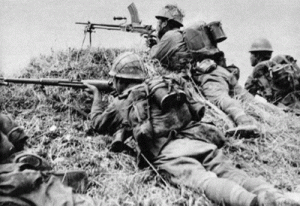 |
| Here you see IJA troops attaching their mess kits to the outside of their “Takoashi Kaban,” Octopus rucksacks in the standard way. |
I was lucky enough to pick up an original WW2 issue IJA mess kit from a seller in Japan, and at a fairly reasonable price, so I thought I would share some pictures and info with you. As stated, this mess kit has the soldier’s name scratched into the paint on it. His name is Kimura.
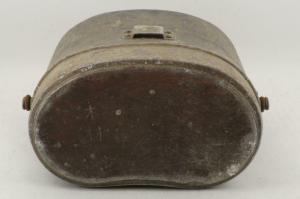 |
| The soldier scratched his name into the mess kit, seen here on the left side of the mess kit top, it says, “Kimura”. |
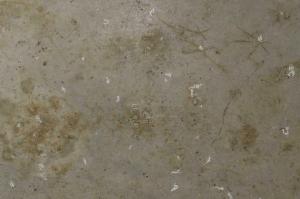 |
| Here you see Kimura San’s name scratched into the inner pan near the manufacturer’s markings. |
Kimura San’s mess kit also has markings indicating the date of manufacture and material it was made from.
The year of production is “2600” in the Ancient Nippon Calendar, or 1940, which is 660 years in advance the Gregorian Calendar. The material data says, “made using substitute materials,” which was a common practice after 1938 due to materials shortages resulting from sanctions imposed on Japan by the United States due to the invasion of China. The material may have contained toxic metal alloys and could have been the cause of illness among Japanese soldiers during WW2.
Kimura San’s mess kit now resides with a historical researcher in Fredericksburg, Texas, the home of the National Museum of the Pacific War. The researcher, COL Ted Smith, uses it to demonstrate the techniques used by Japanese soldiers to cook their meals during WW2. Due to the “substitute materials” used in its manufacture, COL Smith dos not allow the food cooked in the mess kit to be eaten for fear of toxic substances that the Japanese Army may not have fully understood, or even cared about, during WW2.
I just acquired another red-cupped KVP Medical Canteen and it is in such great condition that I felt I should share it with you. So, shall we have another? Of course. “Fräulein, noch eine, bitte!”
In my previous post I showed you some KVP Sanitäter Feldflaschen. I mentioned that the red-cupped versions may have been used by the German Red Cross (DRK) based upon a blog post that I ran across. This single mention sent me down the research rabbit hole to discover the use of Feldflashen by the DRK. I was successful in my research and I will share that data at the bottom of this post. Suffice it to say that the DRK in DDR used the same canteens as the KVP and NVA, with and without red cups.
This feldflasche is an earlier version, from what I can tell, and seems to have been in use between 1949 and the 1960s. The felt cover is a lighter grey color. My other canteens of this period have grey/brown and dark feldgrau/green covers. The cover has four black-painted snaps, like my other canteens, but these snaps appear to be brass and the others appear to be steel.
The cup on this canteen is clearly marked and painted a rich bownish/red color. As with the other early style cups, the strap loop is riveted to the cup and there are no folding handles like the newer cups.
As promised, I will include some info about the DRK in DDR’s use of KVP & NVA Feldflaschen. I found this information on a German website about the DRK in DDR (drk-ddr.de) It is highly detailed and documents much of the history from the 1950s through to the reunification. It helps to speak/read German, of course.
This display is that of the equipment carried by German Red Cross members in the DDR. You will see the Feldflasche does not have a red cup or a shoulder strap. This equipment was carried by non-medical Red Cross employees. The description of the equipment states that the bread bag, Brotbeutel, is either worn on the belt or carried over the shoulder with its strap. The mess kit, Essgeschirr, is strapped to the outside, right, of the bread bag with the strap seen between the canteen and mess kit. The Feldflasche is strapped to the left. The eating utensils nest together and are carried in the Brotbeutel. The flashlight is designed to hang from a pocket button, just like the WW2 Wehrmacht flashlight.
This is the Sanitäter Feldflasche shown on the DRK-DDR webpage. It has many similarities to my latest addition, including the embossed edge on the brown leather strap. The webpage says this canteen was used during the ’50s and ’60s.
The DRK-DDR website says this model of Sanitäter Feldflasche was used from the 1960s to 1989. I have seen these canteens for sale before but never knew if they were real or put-together for the surplus market. Now I guess I have to get one!
By far, the most interesting thing I learned on the that website was the existence of the following canteen, which I have never seen before. This is the model 1990 medic canteen. The Hunt Continues! Tell the Fräulein to keep them coming.
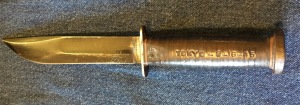 |
| Western Cutlery Shark Knife personalized by a sailor in TF58 after the raids on Tokyo, 2 – 16 – 45. |
Its not every day that a collector/historian has a documented piece of history fall into his lap, but the knife pictured above was offered for sale in an online auction by a seller that didn’t know exactly what he had, besides, “Old Knife Stamped Tokyo.” Well, that description is not likely to draw the attention of knife collectors that want World War Two era knives, or knives made by the Western Cutlery Company, Boulder, Colorado. I stumbled across it and bought it as soon as I realized what it was. My knife collecting karma was strong that day.
The Western Cutlery Company, like most sizeable knife companies during World War Two, produced a number of knives for military contracts as well as knives that were popular private-purchase knives carried by many GIs and Sailors around the globe. The model G-48-6 or Shark knife, as this model became known, had a 6 inch blade with a fuller and a false edge on top, a round, welded pommel (like the L71 “Seabee” knife which the USN accepted as the MK1) and leather washer handle with vulcanized, hard rubber spacers colored black, red, black, like many of their commercial knives. Western already had a history as one one of the few knife makers in America that was not centered around the New England area, the traditional area for American knife makers. Western opened shop in Boulder, Colorado, in 1896 and didn’t close its doors until February, 2007. Western also produced the G-48-8, a knife that was very similar but had an 8 inch blade. The G-48-8 was accepted by the US Navy as a version of the MK2.
This particular knife not only has the stamping shown above, TOKYO – 2-16 – 45, but also has the sailor’s name and rate stamped on the other side of the leather handle. The date was what caught my eye initially. February 16th, 1945, is only three days before the invasion of Iwo Jima. This knife was involved in an operation that had two historically significant characteristics. First was that the carrier based attack on Tokyo, 16 – 17 February, 1945, was the first such attack on Tokyo since the Doolittle Raid in April, 1942. Second, it was designed to draw Imperial Japanese Naval Air Forces away from Iwo Jima in order to allow the US Navy and Marine Corps to have air superiority over Iwo. This operation was carried out by Fast Carrier Task Force 58 and was labeled, “Operation Jamboree.”
The air attack on Tokyo consisted of over one thousand aircraft. Naval aviation attacked Tokyo’s industrial center, including aircraft manufacturing plants, Japanese military airfields, and ships in Tokyo harbor. The Japanese response was tepid and the attacks damaged aircraft and ships with little resistance.
The man that owned this knife is something of an enigma. His name, according to the stampings on the handle, was V. L. Moretti and his rate was SK 1/C, or Storekeeper 1st Class. He was an E-6 and worked in stores, or was a supply NCO, in Army parlance. How did a supply NCO get a knife? That one is not hard to imagine, he had access to all the stores. Did he actually fly on a mission over Tokyo? Perhaps, as stated there were over a thousand aircraft involved in the attack and dive bombers had a crew of two, a pilot and a machine gunner. Could our intrepid SK 1/C have flow as a gunner on a Helldiver? I think the chances are better than average. Now, there is such an sailor as an Aviation Storekeeper, but that rate was known as AS, not SK, like our hero.
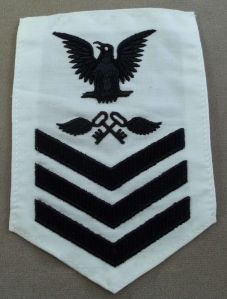 |
| Aviation Storekeeper 1st Class, AS 1/C |
 |
|||||||
| Storekeeper 1st Class, SK 1/C |
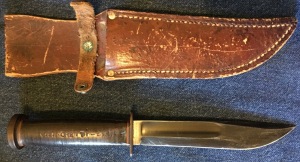 |
| The handle is marked, V.L.Moretti – SK 1/C |
I wish I knew more about this sailor and the story of his trip to Tokyo on 16 February, 1945, but I am content to know that this tiny piece of World War Two history has a safe and appreciative home in my collection. God Speed, SK 1/C Moretti. I hope to rally with you on the high ground.
On 19 February, 1945, three days,after SK 1/C Moretti’s adventures over Tokyo, US Marines landed on Iwo Jima.
 |
| US Marines land on Iwo Jima, 19 February, 1945. |
Also, check out my YouTube video about this knife for video of the actual attack on Tokyo!!
https://www.youtube.com/watch?v=ahzJSVLXJnYhttps://www.youtube.com/watch?v=ahzJSVLXJnY
Welcome back! Today we are looking at another type of canteen used by the KVP, the forerunner to East Germany’s National Volksarmee. Going back at least as far as World War 1, the German military has had a practice of combat medics, Sanitäter, carrying a second canteen for use with patients on the battlefield, commonly referred to as the Sanitäter Feldflasche, or Sanitäter Trinkflasche. While the Sanitäter carried his own Feldflasche on his breadbag, he carried another on a shoulder strap that he could share with patients.
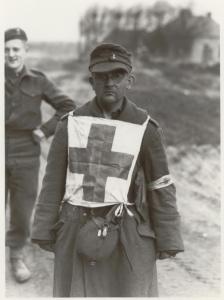 |
| A captured German Sanitäter with his Feldflasche slung over his shoulder during WW2. |
Our first example of the KVP medic canteen, seen in the photos below, has a field grey felt cover over the unpainted aluminum canteen body. The drinking cup is painted grey and maker marked on top. It has brown leather fastening straps and a webbed canvas carrying strap.

If any readers can confirm or deny the info about red cups being issued to the DRK, please comment below!
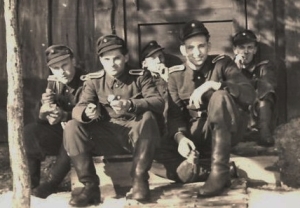 |
| KVP troops, in the 1950s. The NCO at the right, front carries his Feldflasche which resembles the WW2 era M31 canteen. |
The Kasernierte Volkspolizei (KVP) was the forerunner of the National Volksarmee (NVA) of the DDR. You will most often see Kasernierte Volkspolizei translated into English as the “Barracked People’s Police.” While this is meant to convey that these troops were housed in barracks, that is not the definition of “barracked” in English. ‘Kasernierte” means to be on a Kaserne, or military base. It makes more sense in English to say these troops were garrisoned, which also means to be on a military base. All of that aside, I will refer to them as the KVP.
The KVP was formed in July 1952 under the Miniterium des Innern (MdI). Even after being re-named the National People’s Army, or Nationale Volksarmee (NVA), the East German Army was still referred to as VOPOs, which is how the Germans abbreviated Volkspolizei.
The early KVP was outfitted with gear that was similar to gear issued to the Wehrmacht during WW2 and the following examples of canteens, Feldflashe, are demonstrative of that point. The KVP Feldflasche was extremely similar to the Model 1931 canteens carried by German forces during WW2.
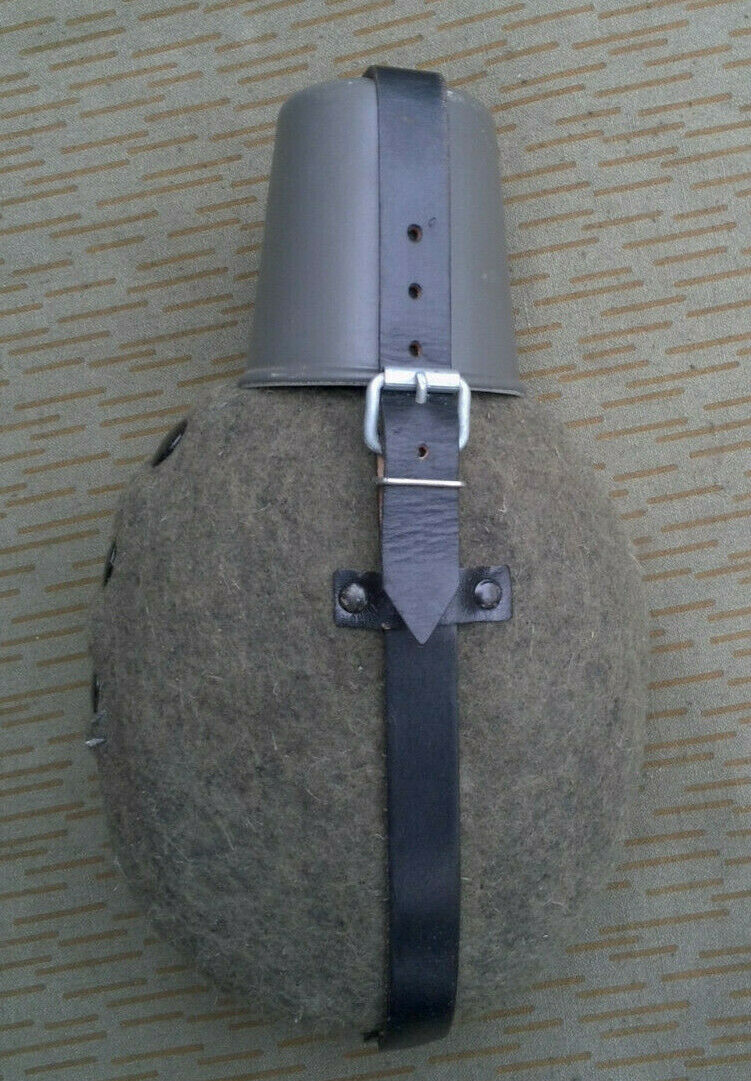 |
| Here you can see an early KVP Feldflasche that bears a strong resemblance to a WW2 era M31 canteen. |
Early KVP Feldflasche had the wool/felt covers with leather straps, just like their WW2 counterparts. The bodies of the Feldflasche were aluminum, as were the cups. The cup pictured here is a Feldgrau gray/green color with a riveted strap loop.
The manufacturer’s mark is clearly shown on this cup.
The clip that holds the Feldflasche to the bread bag, or Brotbeutel, is aluminum with a stainless steel clip riveted to it. There are no markings on the clip.
The screw-on cap has a red rubber gasket in it to keep the bottle from leaking.
There are four black painted snaps on the side of this canteen cover.
The top of the screw-on cap is marked “DDRI.”
Here you can the unpainted aluminum bottle and the inside of the four snaps with their cotton herringbone twill reinforcement material. Other early style canteens had green painted aluminum bottles.
The underside of these snaps are marked, “KIN5.”
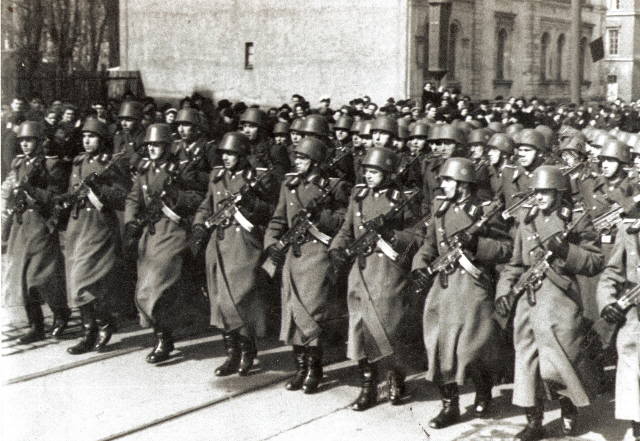 |
| KVP troops parade in Berlin, 1952. Note the very early and extremely rare M54 helmets and their WW2 StG44 rifles. |
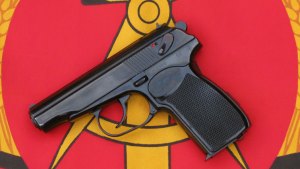 |
| East German manufactured Makarov pistol in 9X18mm. The DDR referred to it as the Pistole Makarov or PM. Photo credit to the American Rifleman. |
The former East Germany or Deutsche Demokratische Republik (DDR) had a number ministries and offices. The DDR Ministry of the Interior, or Ministerium des Innern (MdI) was established in 1949. The MdI was one of the ministries of the armed forces and was responsible, among other things, for the People’s Police or Volkspolizei, also known as the VoPo, and the combat groups, the Kampfgruppen. In 1963 the official title of the Minister of the Interior of the DDR became Chef der Deutschen Volkspolizei or Chief of the German People’s Police.
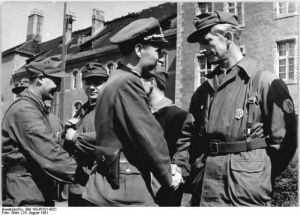 |
| Berlin, 24 August 1961. In this photo a VoPo Major named Retig presents awards to VoPo soldiers for their outstanding work while building the Berlin wall. On his right hip he wears a PM holster like the one in this post. Bundesarchiv photo Bild 183-85701-0021 |
The MdI also oversaw the firefighting brigades, the penal system, the passport and citizenship registration system, motor vehicle registration and the issuance of driving licenses. The Secretary of State for Church Affairs was also technically and politically responsible to the MdI. DDR border guards fell under the MdI and were members of the VoPo. All of this history lesson on the communist Germans to help you understand the significance of the Makarov pistol holster shown here.
This black leather PM holster has the rounded edge to the cover flap as opposed to the Russian style holsters that have squared off butt end flaps. It has the spare magazine pouch but does not have the loops to secure a cleaning rod as many PM holsters have.
Here you can see the closure strap goes from the bottom up to a stud on the flap and that the closure is secured to holster by a rivet at the rear which also secures the belt loop.
This holster is marked with two separate MdI acceptance marks, one large in a rectangle, the other smaller in a circle. The markings above the rectangle are the date of manufacture but are unclear in this specimen. These markings normally consist of a Roman numeral indicating the quarter of the year, a slash and two numbers indicating the year. For instance, this specimen could read, “II/80” for the second quarter of 1980.
The two sets of four numbers separated by a slash below the triangular marking are the codes assigned to the manufacturer, in this case, 1408/1678 is VEB Lederfabrik Zug. The triangular marking is interesting and it was suggested to me that it may say, “BAHN” inside the triangle, which could indicate that the holster was issued to the Railway Security Police, Bahnschutz Polizei.
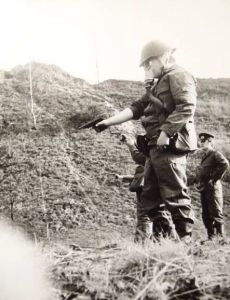 |
| Here VoPos practice with their PM while wearing chemical protective masks. |
These two East German (DDR) army field gear items represent the most common and least common pieces I have in my collection of early DDR National Volks Armee (NVA) and Volspolizie (VoPo) field gear. The 3 cell magazine pouch for the Machinepistole Kalashnikov (MPiK) is probably the most common piece of early DDR NVA Blumentarn (flower camo) gear available to American collectors today. Plus they hold AK magazines, which is always useful. The canteen is far less common but I might stop short of saying it is “rare.”
The camo pattern was officially known as the M58 “Flachtarnenmuster” or flat camouflage pattern. It was issued to NVA and “Ministerium des Innern” (MdI) Interior Ministry troops between 1956 and 1967. It was also known as “Kartoffelmuster” or potato pattern. Collectors began picking these pieces up in the 1990s rather inexpensively. Prior to the fall of the wall, DDR gear commanded a premium price among collectors of commie gear.
Gear and field uniforms in this pattern were shared around the world with communist and communist supported militaries, terrorists and “freedom fighters.” The communist fomented struggle in South West Africa, now Namibia, included the SWAPO, South West African People’s Organization, a communist guerilla movement that received military aid from the DDR and Cuba. SWAPO terrorists were equipped with Blumentarn equipment.
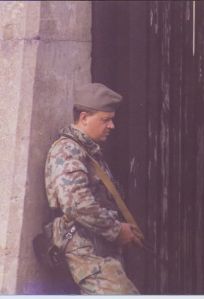 |
| VoPo border guard wearing the Blumentarn camo uniform. |
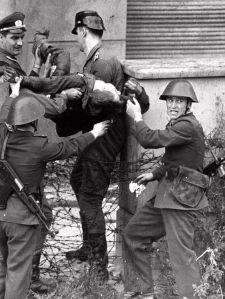 |
| Here a VoPo border guard wear the 3 cell Blumentarn MPiK magazine pouch. The man being carried is being brought back to the DDR after an unsuccessful escape attempt. |
This magazine pouch has three cells for AK magazines. On the back of the pouch are two heavy, webbed belt loops and a steel “D” ring to accept the fastener from the combat suspenders. The loops and ring fasteners are sewed and riveted. Even the stress points at the tops of the magazine cells were rivited. With three magazines inserted, the flap is tight when secured with the small metal studs, as you can see in the photo below of the pouch along side an MPiKM with a folding stock.
The interior of the magazine cells is lined with heavy grey colored canvas and separated by walls between each cell. The two steel fastening studs were secured in heavy canvas circles. After 50 to 60 plus years, these studs were still secure and strong. Durability was built into this simple magazine pouch.
The least common piece of NVA Blumentarn gear I have is the Feldflasche or canteen. The canteen is the first in a series of three plastic water bottles that followed the M31 style Feldflasche adopted by the NVA and MdI. The earliest bottles, the M31s, were very nearly identical to the WW2 issued canteens. Between 1958 and 1961 a Blumentarn Feldflasche was issued that had a crossed stitching on the clothe cover. That model also had a grey/green colored strap and a chromed snap link. This style rivets holding the strap loop of the cup was continued into the next version, below. It is important to note that this cup does not have the folding handles seen in following versions.
The style shown here were issued between 1962 and 1970. They included an aluminum cup with folding handles. This cup is similar to the M31 cup in that it has two rivets holding the strap loop in place. The cup is painted field grey like the M31 cup as well. At the bottom of this post you will see another Blumentarn Feldflasche that has a welded strap loop like the next version that uses the Strichtarn or rain pattern camo cover.
Blumentarn camo covered DDR NVA Feldflasche with canteen cup, front and rear. The cup has folding loop handles. When compared with the later Strichtarn Feldflasche, the paint on the aluminum cup of this canteen has a greener hue to it, the later being more grey in appearance.
This is a good view of the snap link that holds the Feldflasche to the bread bag or Brotbeutel. You can also see the steel stud that holds the loop to the canteen cover. The black plastic, pig skin leather texture embossed strap has anthoer layer beneath it that is whitish plastic.
These images clearly show the rivets in the strap loop and the handle bracket. The later versions are spot welded and the strap loop is considerably closer to the buckle than on this version.
Here you can see the graduation marks on the cup that are hidden under the strap. Below you can see the rivets from the inside of the cup.
The bottom of the Blumentarn cover is a separate, oval shaped piece that is reinforced with an “X” in stitching. Later models do not have this feature. Below you can clearly see the four snaps on this cover. Strichtarn models have only three snaps. The snaps are painted black.
The snaps are reinforced with a “pleather” disk. The inside of the top female snaps on this Feldflasche are marked “OL55.” I do not know if 55 indicates 1955. These covers were introduced in 1958.
The inside of the bottom male snaps are marked with a pattern that resembles a snowflake. The inside of the Feldflasche cover is a white felt material. In the pic below you can just make out a small purple colored marking that I cannot determine. In the center you can see the rivets that hold the strap. You can see the pleather reinforcements.
The water bottle itself is plastic with a plastic, screw on cap and a thin steel chain. This is the first plastic water bottle introduced to the NVA. The model previous to this one (M31 style) had an aluminum water bottle. This bottle has a 0.65 liter capacity. That is pretty small by US standards. The standard US military canteen is 1 quart, which is 0.95 liters.
The cap is sealed with a red/brown colored seal. My Feldflasche still smells a little musty after all these years.
This is a photo of a Blumentarn Feldflasche that I found on the internet. The cup on this version is spot welded and not riveted. Based on the placement of the strap loop and the spot welds, I think this Feldflasche has a later version cup like those on the Strichtarn Feldflaschen.